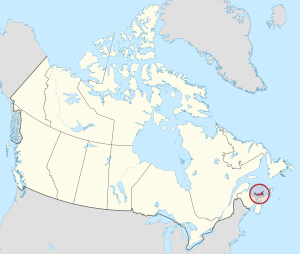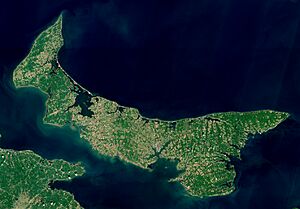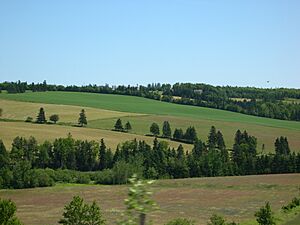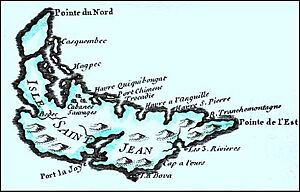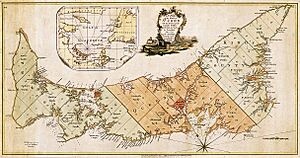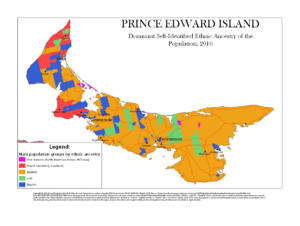Prince Edward Island facts for kids
Quick facts for kids
Prince Edward Island
Île-du-Prince-Édouard (French)
|
|||
|---|---|---|---|
|
|||
| Motto(s): | |||
| Country | Canada | ||
| Confederation | July 1, 1873 (8th) | ||
| Capital | Charlottetown | ||
| Largest city | Charlottetown | ||
| Largest metro | Charlottetown | ||
| Government | |||
| • Type | Parliamentary constitutional monarchy | ||
| Area | |||
| • Total | 5,660 km2 (2,190 sq mi) | ||
| • Land | 5,660 km2 (2,190 sq mi) | ||
| • Water | 0 km2 (0 sq mi) 0% | ||
| Area rank | Ranked 13th | ||
| 0.1% of Canada | |||
| Population
(2021)
|
|||
| • Total | 154,331 | ||
| • Estimate
(Q2 2024)
|
177,081 | ||
| • Rank | Ranked 10th | ||
| • Density | 27.27/km2 (70.6/sq mi) | ||
| Demonym(s) | Prince Edward Islander, Islander, PEIer | ||
| Official languages | English (de facto) | ||
| GDP | |||
| • Rank | 10th | ||
| • Total (2017) | 6.652 billion | ||
| • Per capita | C$36,740 (13th) | ||
| HDI | |||
| • HDI (2021) | 0.930 — Very high ([[List of Canadian provinces and territories by Human Development Index|4th]]) | ||
| Time zone | UTC-04:00 (Atlantic) | ||
| Postal abbr. |
PE
|
||
| Postal code prefix |
C
|
||
| ISO 3166 code | CA-PE | ||
| Flower | Pink lady's slipper | ||
| Tree | Red oak | ||
| Bird | Blue jay | ||
| Rankings include all provinces and territories | |||
Prince Edward Island (PEI), also known as Île-du-Prince-Édouard in French, is one of Canada's thirteen provinces and territories. It is the smallest province in terms of land area and population. However, it is the most densely populated.
This island has many nicknames, like "Garden of the Gulf" and "Birthplace of Confederation". Its capital and largest city is Charlottetown. PEI is one of the three Maritime provinces and one of the four Atlantic provinces.
The Miꞌkmaq people lived here first. French settlers arrived in 1604, calling the island Isle St-Jean. After the Seven Years' War in 1763, the British took control. The island became part of Nova Scotia. In 1769, it became its own British colony. Its name changed to Prince Edward Island (PEI) in 1798.
PEI hosted the Charlottetown Conference in 1864. This meeting discussed joining the Maritime provinces. It became the first step toward Canadian Confederation in 1867. Prince Edward Island joined Canada on July 1, 1873. It was the seventh province to join.
In 2023, Prince Edward Island had about 176,113 residents. Farming is a major part of its economy. The island grows 25% of Canada's potatoes. Other important jobs are in fishing, tourism, aerospace, and renewable energy. Many people on PEI have family names from early settlers. These include Acadian, Scottish, Irish, and English names.
Prince Edward Island is in the Gulf of St. Lawrence. It is about 10 km (6 miles) from Nova Scotia and New Brunswick. The island is about 200 kilometres (120 miles) north of Halifax. It is also 600 kilometres (370 miles) east of Quebec City. The island covers 5,686.03 km2 (2,195.39 sq mi). It is the only Canadian province made up of just one island.
Contents
- Island's Name: Where Did It Come From?
- Island Geography: What Does PEI Look Like?
- Island Life: Plants and Animals
- Island History: A Look Back in Time
- Island People: Who Lives Here?
- Island Economy: How People Make a Living
- Island Learning: Education in PEI
- Island Travel: Getting Around PEI
- Island Culture: Arts, Festivals, and Sports
- Sister Province
- See also
Island's Name: Where Did It Come From?
The Mi'kmaq people, who lived here first, called the island Abegweit or Epekwitk. This means "land cradled in the waves".
When the French settled the island, they named it Île Saint-Jean (St. John's Island). Today, in French, it is called Île-du-Prince-Édouard (IPE).
In 1798, the island's name was changed to Prince Edward Island. This was to honor Prince Edward, Duke of Kent and Strathearn. He was the fourth son of King George III. He was also the father of the future Queen Victoria. Prince Edward is sometimes called "Father of the Canadian Crown".
Many places on the island are named after him:
- Prince Edward Battery in Charlottetown
- Kent College, which became the University of Prince Edward Island
- Kent Street in Charlottetown
- West Kent Elementary School
- Kent Street in Georgetown
In Scottish Gaelic, the island's name is Eilean a' Phrionnsa. This means "the Island of the Prince".
Island Geography: What Does PEI Look Like?
Prince Edward Island is in the Gulf of St. Lawrence. It is west of Cape Breton Island and north of Nova Scotia. Its southern shore touches the Northumberland Strait. PEI is Canada's most densely populated province.
The largest city area is around Charlottetown Harbour. This includes Charlottetown and the towns of Cornwall and Stratford. A smaller city area is around Summerside Harbour. This area includes Summerside.
The coastline has long beaches, sand dunes, and red sandstone cliffs. There are also salt water marshes and many bays. The red color of the cliffs and sand comes from iron. This iron turns red when it touches the air.
The sand at Basin Head is special. It makes a scrubbing noise when you walk on it. People call it "singing sands". Large sand dunes on the north shore are important. The dunes at Greenwich are home to rare birds and plants. They are also important for archeological discoveries.
Island Weather: What's the Climate Like?
The island's weather is moderate. It is strongly affected by the surrounding Gulf of St. Lawrence. The water keeps the island milder than other nearby areas. The weather changes often throughout the year.

In July and August, the average daytime high is 23 °C (73 °F). Sometimes, it can get hotter than 30 °C (86 °F). In January and February, the average daytime high is −3.3 °C (26 °F). The island gets about 855 millimetres (33.7 in) of rain each year. It also gets about 2.85 metres (9.4 ft) of snow.
Winters are long and cold, but milder than inland places. Storms from the Atlantic or Gulf of Mexico often bring rain or snow. Spring stays cool until the sea ice melts, usually in late April or early May.
Summers are warm, but temperatures rarely reach 30 °C (86 °F). Autumn is pleasant because the warm Gulf waters delay frost. It rains a lot throughout the year, especially in late autumn and early winter.
Island Water: Where Does Drinking Water Come From?
Prince Edward Island gets all its drinking water from underground. This is called groundwater. The water is naturally filtered as it flows through the ground. Charlottetown gets its water from thirteen wells. Rain helps to refill the underground water supply.
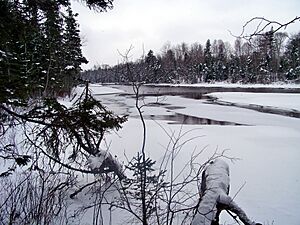
The Winter River watershed provides about 92% of Charlottetown's water. The provincial government checks the quality of drinking water. They test for many things like minerals and pesticides. This ensures the water is safe to drink.
Island Life: Plants and Animals
Prince Edward Island used to have large animals like moose, bears, and wolves. But because of hunting and changes to their homes, these animals are no longer found here.
Some common animals on PEI today are red foxes, coyotes, blue jays, and robins. Skunks and raccoons are also common. Some animals on PEI are at risk of disappearing. These include piping plovers, american eels, and little brown bats.
In 2008, a new type of fungus, Jahnula apiospora, was found here. It was on wood in a freshwater creek.
North Atlantic right whales, which are very rare, are now seen more often near PEI. In 2015, about 35 to 40 whales were seen around Cape Breton to Prince Edward Island.
Island History: A Look Back in Time
Before Europeans arrived, the Mi'kmaq First Nations lived on Prince Edward Island. They called it Epekwitk, meaning "cradled on the waves". Another name they used was Minegoo. The Mi'kmaq believed the island was formed by the Great Spirit. Today, two Mi'kmaq communities live on PEI: Abegweit First Nation and Lennox Island First Nation.
French Settlement and Conflicts
In 1534, Jacques Cartier was the first European to see the island. In 1604, France claimed the land. They called the island Île Saint-Jean. The Mi'kmaq did not agree with this claim. But they welcomed the French as trading partners.
In the 1700s, France and Great Britain fought many wars. Battles happened on Prince Edward Island. In 1745, New Englanders attacked Île Saint-Jean. They burned the capital to the ground. French soldiers and their Mi'kmaq allies fought back. They drove the New Englanders away.
In 1746, more fighting occurred near York River. French and Mi'kmaq forces defeated New Englanders. The fighting ended in 1748 with the Treaty of Aix-la-Chapelle.
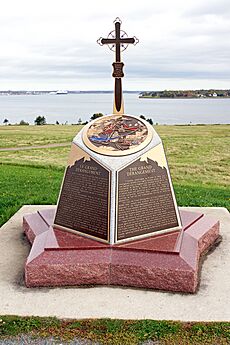
Many Acadians lived on the island. After 1755, the British forced many Acadians to leave. This was called the Acadian expulsion. Many Acadians died on ships going to France. In 1763, France officially gave the island to the British.
British Rule and Joining Canada
The British first called the island St. John's Island. It was part of Nova Scotia until 1769. Then it became its own colony. In 1767, the island was divided into 67 lots. These lots were given to supporters of King George III. But the land stayed with owners in England. This made the island settlers angry. They could not own the land they worked on.
In 1775, during the American Revolutionary War, American privateers attacked Charlottetown. They captured the attorney-general.
After the American Revolutionary War, many Loyalist refugees came to the island. They were people who supported Britain during the war. In 1798, the British government changed the colony's name. It became Prince Edward Island. This honored Prince Edward Augustus.
In 1853, the island government tried to buy land from owners. They wanted to sell it cheaply to settlers. But they ran out of money.
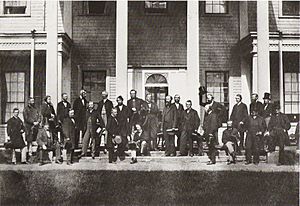
From September 1 to 7, 1864, PEI hosted the Charlottetown Conference. This meeting led to the creation of Canada. Prince Edward Island did not join Canada in 1867. It stayed a British colony.
In 1871, the colony started building a railway. In 1873, Canadian Prime Minister John A. Macdonald wanted PEI to join Canada. Canada agreed to pay PEI's railway debts. They also agreed to buy land from the English owners. This helped settlers own their land. Prince Edward Island joined Canada on July 1, 1873.
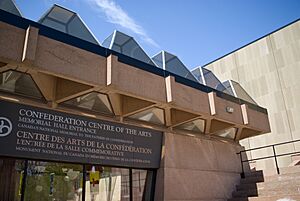
Because it hosted the Charlottetown Conference, PEI is called the "Birthplace of Confederation". The Confederation Centre of the Arts in Charlottetown celebrates this event. It is a national monument to the "Fathers of Confederation".
Island People: Who Lives Here?
| Historical populations | ||
|---|---|---|
| Year | Pop. | ±% |
| 1851 | 62,678 | — |
| 1861 | 80,857 | +29.0% |
| 1871 | 94,021 | +16.3% |
| 1881 | 108,891 | +15.8% |
| 1891 | 109,078 | +0.2% |
| 1901 | 103,259 | −5.3% |
| 1911 | 93,728 | −9.2% |
| 1921 | 88,615 | −5.5% |
| 1931 | 88,038 | −0.7% |
| 1941 | 95,047 | +8.0% |
| 1951 | 98,429 | +3.6% |
| 1956 | 99,285 | +0.9% |
| 1961 | 104,629 | +5.4% |
| 1966 | 108,535 | +3.7% |
| 1971 | 111,635 | +2.9% |
| 1976 | 118,225 | +5.9% |
| 1981 | 122,506 | +3.6% |
| 1986 | 126,640 | +3.4% |
| 1991 | 129,765 | +2.5% |
| 1996 | 134,557 | +3.7% |
| 2001 | 135,294 | +0.5% |
| 2006 | 135,851 | +0.4% |
| 2011 | 140,204 | +3.2% |
| 2016 | 142,907 | +1.9% |
| 2021 | 154,331 | +8.0% |
| Source: Statistics Canada | ||
Ethnic Backgrounds
In 2016, most people on PEI had European backgrounds. The largest groups were Scottish (36%), English (29%), Irish (28%), and French (21%).
PEI has very few visible minority groups. Chinese Canadians are the largest visible minority group. They make up 1.3% of the population. Almost half of the people said their ethnicity was "Canadian".
Languages Spoken on PEI
In 2021, the most spoken language was English. About 99.36% of people spoke it. French was spoken by 12.92% of people. Other languages included Mandarin, Hindi, and Tagalog.
Many people on PEI are learning French. About 23.5% of young people aged 15 to 19 can speak both English and French. This is twice as many as ten years ago.
Religions on the Island
Most people on Prince Edward Island are Christian. In 2021, about 67.6% of people were Christian. About 28.5% said they had no religion. Other religions like Islam, Hinduism, and Sikhism are also present.
Traditionally, the population was split between Catholic and Protestant faiths. In 2001, 47% were Roman Catholic. About 43% belonged to various Protestant churches.
Island Economy: How People Make a Living
The economy of PEI depends on farming, tourism, and fishing. Tourists visit all year round. They enjoy beaches, golf courses, and cultural events. Farming is the main industry, just like in colonial times.
In 2015, farming and food making made up 7.6% of the province's economy. About 594,000 acres (240,383 hectares) of land are used for farming. In 2016, there were 1,353 farms on the island.
PEI is Canada's largest supplier of potatoes. About 330 potato growers live on PEI. Most are family farms. The province grows about a quarter of Canada's potatoes. This is about 1.3 billion kilograms (1,400,000 short tons) each year. PEI also sells seed potatoes to over twenty countries.
Many coastal communities rely on fishing. They catch lobster, oysters, and farm mussels.
PEI's economy has also grown in new areas. These include aerospace, bioscience, and renewable energy. Aerospace makes up over 25% of the province's international exports. It is the fourth largest industry. The bioscience industry employs over 1,300 people.
In 1976, PEI banned selling drinks in non-refillable cans or plastic bottles. This was to help the environment. Companies used refillable glass bottles instead. This also helped local bottling companies. The ban was lifted on May 3, 2008. Now, cans and plastic bottles can be recycled.
In 2013, PEI changed its sales tax. It became the harmonized sales tax (HST) at 15%. This tax is on most goods and services.
Island Energy: Powering PEI
Maritime Electric has provided electricity since 1918. About 25% of the island's electricity comes from renewable energy. This is mostly from wind turbines. The island has eight wind farms. The largest is West Cape Wind Park.
Most of PEI's electricity comes from New Brunswick. It travels through undersea cables. These cables were upgraded to carry more power.
Island Learning: Education in PEI
Prince Edward Island has two public school systems. One is for English speakers, called the Public Schools Branch. The other is for French speakers, called the Commission scolaire de langue française. The English district has 10 high schools and 54 elementary schools. The French district has 6 schools for all grades. About 22% of students learn in French immersion.
PEI has three public post-secondary schools. The University of Prince Edward Island (UPEI) is the only public university. It is in Charlottetown. UPEI is also home to the Atlantic Veterinary College. This college offers the only veterinary medicine program in the region.
Collège de l'Île is a French college. Holland College is an English college. Holland College has special facilities. These include the Atlantic Police Academy and the Culinary Institute of Canada.
Island Travel: Getting Around PEI
PEI's transportation used to rely on its seaports. These ports were linked to a railway system. There are also two main airports in Charlottetown and Summerside. The railway system was closed in 1989. Highways were improved instead.

Before 1997, ferries connected PEI to the mainland. In May 1997, the Confederation Bridge opened. It connects Borden-Carleton to New Brunswick. It is the world's longest bridge over ice-covered waters. The bridge replaced the ferry service. It has changed tourism and trade on the island.
PEI has many roads. The province manages 3,824 kilometres (2,376 mi) of paved roads. It also has 1,558 kilometres (968 mi) of unpaved roads. PEI has strict rules about roadside signs. Billboards are not allowed.
The Charlottetown Airport (CYYG) has several airlines. The Summerside Airport (CYSU) is for smaller planes.
The Confederation Trail is a 470 kilometres (290 mi) long trail. It is great for biking and hiking. This trail used to be a railway line.
Island Culture: Arts, Festivals, and Sports
Arts and Creativity
PEI supports art, music, and writing through its schools. The Charlottetown Festival is an annual arts festival. It is held at the Confederation Centre of the Arts.
Lucy Maud Montgomery was born on PEI in 1874. She wrote the famous novel Anne of Green Gables (1908). The story is set on the island. The musical play Anne of Green Gables has been performed every year at the Charlottetown festival for over forty years. The real Green Gables house is in Cavendish.
PEI has a rich music history. Today, you can hear Acadian, Celtic, folk, and rock music. Famous musicians from PEI include Gene MacLellan and Lennie Gallant. Stompin' Tom Connors grew up here. Celtic music is very popular. Fiddling and step dancing are common.
Festivals and Events
Besides the Charlottetown Festival, there is the Island Fringe Festival. The P.E.I. Jazz and Blues Festival is a week of concerts. Other music festivals include Canada Rocks and the Cavendish Beach Music Festival.
Because farming and fishing are important, PEI is known for food tourism. Popular food festivals include the Fall Flavours festival and the Shellfish Festival.
Sports and Recreation
Popular sports on PEI include hockey, curling, golf, and horse racing. Baseball, soccer, rugby, football, and basketball are also played. Water sports are popular in the summer.
PEI has a major junior ice hockey team, the Charlottetown Islanders. They play in the Quebec Major Junior Hockey League. The Summerside Western Capitals are a Junior A team.
PEI hosted the Canada Games three times. They hosted winter games in 1991 and 2023. They hosted summer games in 2009.
The main indoor arenas are the Eastlink Centre in Charlottetown and the Consolidated Credit Union Place in Summerside.
Sister Province
Hainan, China, has been PEI's sister province since 2001. They work together on trade and other projects.
See also
 In Spanish: Isla del Príncipe Eduardo para niños
In Spanish: Isla del Príncipe Eduardo para niños




